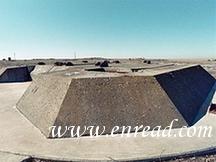| ||||||||||||||||||||||||||||||||||||||||||||||||||||||||||||||||||||||||||||||||||||||||||||||||||||||||||||||||||||||||||||||||||||||||
|
近日,美国政府不慎将一份长达266页的涉核秘密材料上传到美国政府出版物管理局的网站上,导致敏感信息外泄。这份材料上清楚标着“高度秘密”字样,内容涉及美国核设施的发展规划以及相关核设施的准确位置、分布图等。泄密事件发生后,美国核问题专家对泄密情况进行了评估并表示,此次涉核秘密泄漏事件的损失不是很大,因为,这份材料中的大部分信息都是宏观层面上的,公众有可能已经有所了解。 Image otained from the eBay auction1 website shows a former US ballistic missile facility at Lake Moses, Washington. The US government accidentally made public a secret report detailing its nuclear sites, programs and even exact locations of nuclear stockpiles. The government's inadvertent and red-faced Internet posting of a 266-page list of US nuclear sites provided a one-step guide for anyone wanting details about such sensitive information. Obama administration officials said Wednesday the document contained no classified material about nuclear weapons. They contended the locations and other details already were available from public sources. Energy Secretary Steven Chu said "a snafu" led to the online posting. "A little embarrassing," he acknowledged. The document, stamped "highly confidential2 safeguards sensitive," made it onto the Government Printing Office's Web site — and why that happened was not immediately clear. A newsletter that focuses on government secrecy3 quickly picked up on it. The printing office removed the document when informed "about the potential sensitive nature" of the list, the agency said. By then it was too late. The information, compiled for international nuclear inspectors4, is a compilation5 of hundreds of civilian6 nuclear sites, along with maps and details of the facilities. The material includes sites for uranium storage, nuclear fuel fabrication plants and nuclear research facilities. "It's an easy locator for civilian sites," Thomas D'Agostino, head of the National Nuclear Security Administration, told Sen. Bill Nelson, D-Fla., when questions about the disclosure came up at a Senate Armed Services subcommittee hearing. "We don't want to make this easier for people to get this kind of information. Unfortunately something like this makes it easier," D'Agostino said. House Speaker Nancy Pelosi, D-Calif., said the release exposed lax safeguards. She asked congressional investigators7 to review the incident. Chu said he was stepping up security at one of the sites, a storage facility for highly enriched uranium at the Y-12 Oak Ridge8 complex in Tennessee. "That's of great concern," he told a House Appropriations9 subcommittee when asked about the disclosure. Oak Ridge holds large quantities of highly enriched uranium, which can be used to fashion a nuclear weapon. The department plans to move the material into $549 million high-security warehouse10 to be competed next year. "There's no secret or classified information that's been compromised. ... The sites and everything are public knowledge," Chu told reporters. Steven Aftergood, director of the Federation11 of American Scientists' government secrecy project, which distributed the document, said he was perplexed12 about all the attention surrounding the disclosure. "Some people are painting this as a road map for terrorists, which it is not," Aftergood said. "It is simply a listing of the numerous nuclear research sites and the programs that are under way. So it poses no security threat whatsoever13." In addition to the Y-12 facility, the document lists facilities at the Hanford nuclear site in Washington state and various civilian nuclear fuel processing sites, including one that produces nuclear fuel for the Navy. Beth Hayden, a spokeswoman for the Nuclear Regulatory Commission, said the agency reviewed the document as it relates to civilian facilities with NRC licenses14. "We are confident that information of direct national security significance was not compromised," she said. The NRC has jurisdiction15 over commercial nuclear power plants and civilian uranium processing and storage facilities. The Government Printing Office processes and produces various congressional documents. The lengthy16 nuclear list was transmitted to Congress in advance of providing it to the International Atomic Energy Agency as part of a nonproliferation-related inspection17 program. Some of the pages are marked "highly confidential safeguards sensitive," a designation used by the IAEA, but not the U.S. government. 点击  收听单词发音 收听单词发音
|
||||||||||||||||||||||||||||||||||||||||||||||||||||||||||||||||||||||||||||||||||||||||||||||||||||||||||||||||||||||||||||||||||||||||
- 发表评论
-
- 最新评论 进入详细评论页>>




